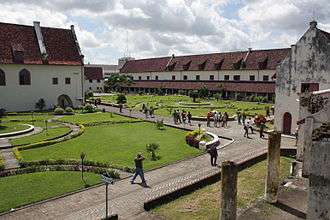Fort Rotterdam

Fort Rotterdam is a 17th-century fort in Makassar on the island of Sulawesi in Indonesia. It is a Dutch fort built on top of an existing fort of the Gowa Kingdom. The original fort, Jum Pandan (allegedly named after the pandanus trees growing in the vicinity), gave its name to the city Ujung Pandang, another name for the city of Makassar.
History

Fort Rotterdam was built on the location of an earlier Makassarese fort, called Ujung Pandang. Although it has been claimed by some authors that this fort dates back to 1545,[1] there is no direct evidence for this, and it seems more likely that the fort was built in 1634, as part of a fortification programme that the Makassar rulers undertook in response to a war with the Dutch East India Company which broke out in this year.[2]
In 1667 Fort Ujung Pandang was ceded to the Dutch as part of the Bungaya Treaty, after the defeat of Gowa in the Makassar War. It was in subsequent years entirely rebuilt on the initiative of Dutch admiral Cornelis Speelman to become the center of Dutch colonial power in Sulawesi.[3] It was renamed Fort Rotterdam after Speelman's place of birth. In the years 1673-1679 it got its five bastions and the 'turtle' shape it still has to this day. This shape gave the fort the nickname "Benteng Penyu" ("sea-turtle fort"). The stone for the construction of the fort was taken from the karst mountains in Maros, the limestone from Selayar and the woods from Tanete and Bantaeng.[4][5] Following the Java War (1825–1830), Javanese prince, and now national hero, Diponegoro was imprisoned in the fort following his exile to Makassar in 1830 until his death in 1855.[6] It was also used as a Japanese prisoner of war camp in World War II.[5]
Fort Rotterdam remained the regional Dutch military and governmental headquarters until 1930s.[3] After 1937, the fort was no longer used as a defense. During the brief Japanese occupation it was used for conducting scientific research in the field of linguistics and agriculture, after which it fell into disrepair.[4]
In the 1970s, the fort was extensively restored.
The fort

Fort Rotterdam lies in the heart of Makassar. It is rectangular in shape, surrounded with 7 meter wall and was equipped with six bulwarks, five of them are still visible: Bastion Bonie (after the Bone state) to the west, Bastion Boeton (Buton Island) to the northwest, Bastion Batjang (Bacan Islands) to the southwest, Bastion Mandassar to the northeast, and Bastion Amboina (Ambon) to the southeast. The sixth bulwark, Bastion Ravelin, is not visible any longer. Some of the bastions still contain some cannons. It is possible to walk over most of the ramparts. A two meter deep moat system used to surround the perimeter of the fort, however only the southwest portion of the moat can still be seen today.[4]
Inside the fort are thirteen buildings, 11 of them are 17th-century original buildings of the fort; most are still good in condition. At the very center of the fort is a church building. Several buildings along the north and south curtain wall still exist: the buildings along the northern curtain wall were some of the oldest buildings (1686), such as the residence of the governor, residence of the senior merchant, of the captain, the predikant, and the secretary, with several storage for weapons. The government's residence at the north-westernmost is nicknamed as "the Speelman's House", however Speelman himself never actually lived in this house. The house was used by the governor of Celebes until the mid 19th-century when he moved to a more comfortable villa in Jalan Ahmad Yani. The Speelman's House now housed one half of La Galigo museum. La Galigo museum kept some prehistoric megaliths from Watampone, as well as ancient weapons, coins, shells, utensils, sketches and stamps.[3] The buildings on the south curtain, originally a storage, housed a museum displaying local skills in silk weaving, agriculture and boatbuilding; and scale models of indigenous boats.[3] The barracks on the eastern wall now housed a small library, featuring old Dutch books that mostly belonged to Reverend Mates, a 19th-century missionary. There is also ships' logs of VOC captains and ancient lontar manuscripts.[4] The department of archaeology is housed in the former building of the head of the administration of VOC; the ground floor of the building, located in the southeast corner of the fort, was formerly a prison.[4]
The other two buildings inside Fort Rotterdam were built by the Japanese during the brief Japanese occupation period.[4]
The southwestern Bastion (Bastion Bacan) contains a prison where Prince Diponegoro was imprisoned for the rest of his life.[6]
The fort is now used to held various events. There is a conservatory for music and dance, archive of the city, and a historic and archaeological institute.[4]
See also
| Wikimedia Commons has media related to Fort Rotterdam. |
References
- ↑ Mattulada 1982, p. 146-147.
- ↑ Bulbeck 1998, p. 79-80.
- 1 2 3 4 Backshall 2003, p. 889.
- 1 2 3 4 5 6 7 Travel Marker 2015.
- 1 2 Andaya 2001, pp. 106-7.
- 1 2 Carey 2001, pp. 112-13.
Works cited
- Andaya, Leonard (2001). Reid, Anthony; Jay, Sian; Durairajoo, T., eds. Indonesia Heritage: Early Modern History - South Sulawesi After Arung Palakka. 3. Singapore: Didier Millet.
- Backshall, Stephen (2003). Rough Guide Indonesia (illustrated ed.). Singapore: Rough Guides. ISBN 9781858289915.
- David Bulbeck, 'Construction History and significance of the Makassar fortifications' in: Living through histories: culture, history and social life in South Sulawesi (Canberra 1998), 67-106.
- Carey, Peter (2001). Reid, Anthony; Jay, Sian; Durairajoo, T., eds. Indonesia Heritage: Early Modern History - Dipanagara and the Java War. 3. Singapore: Didier Millet.
- Mattulada, Mnyusuri Keharidan Makassar dalam Sejarah (Ujung Pandang: Bhakti Baru 1982).
- "Makassar - bezienswaardigheden". Travel Marker (in Dutch). Travel Marker. 2015. Archived from the original on November 19, 2015. Retrieved November 19, 2015.
Coordinates: 5°08′03″S 119°24′20″E / 5.13417°S 119.40556°E